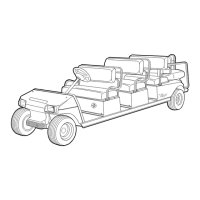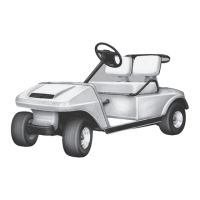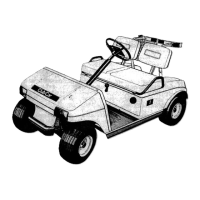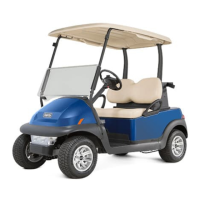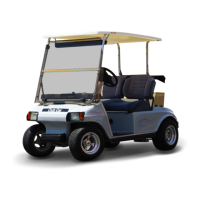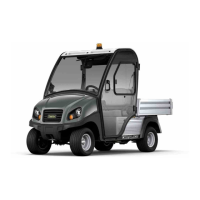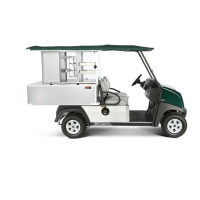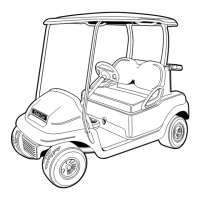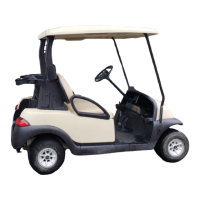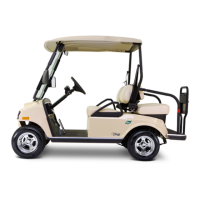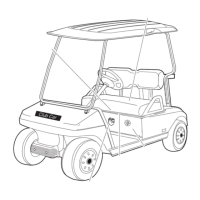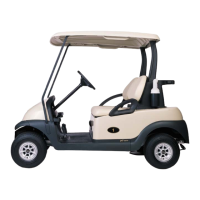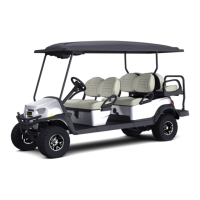
Do you have a question about the Club Car ONWARD HP 6 PASSENGER LIFTED ELECTRIC and is the answer not in the manual?
| Model | ONWARD HP 6 PASSENGER LIFTED ELECTRIC |
|---|---|
| Seating Capacity | 6 passengers |
| Power Source | Electric |
| Lifted | Yes |
| Drive System | Rear-wheel drive |
| Top Speed | Up to 19 mph (30.6 km/h) |
| Color Options | Multiple color options available |
| Battery Type | Lead-acid or Lithium-ion (depending on configuration) |
| Suspension | Independent front suspension |
| Charger | On-board charger |
| Lift Kit | Available |
| Brakes | Self-adjusting brakes |
Information about owning and registering a Club Car vehicle.
Warning regarding chemicals and their potential health effects in California.
Location and identification of vehicle serial number.
Club Car's liability and right to make design changes.
Warnings about modifying the vehicle and potential risks.
Information about warranty registration and dealer provisions.
Compliance with US safety standards for low-speed vehicles.
Compliance with Canadian ICES-002 standard.
Measurement of vehicle vibration and noise levels.
Compliance with various EU directives and standards.
Copyright information for the manual.
General safety practices and warnings for vehicle operation.
Important safety practices to follow before and during operation.
Explanation of signal words like DANGER, WARNING, CAUTION, NOTICE.
Recommends a safety committee for rented or fleet vehicles.
Critical safety information including hazards and operating precautions.
Importance of safety decals and how to maintain them.
Step-by-step guide for operating the vehicle safely.
Safety feature preventing damage during charging.
Describes the audible tones and their meanings.
Explains how regenerative braking works and its limitations.
Safety function limiting roll-away speed when park brake is disengaged.
Critical safety information regarding battery handling and hazards.
Explanation of international safety symbols for batteries.
Information and warnings about lead-acid battery recycling.
Identifies the location of indicators, gauges, and displays on the vehicle.
Explains the information shown on the dash display.
Diagram identifying all vehicle controls and their locations.
Description of the accelerator pedal's function.
Description of the brake pedal's function.
Explanation of the FNR control for vehicle direction.
Controls the operation of the hazard lights.
Controls the operation of the headlights.
Operation of the horn button.
Controls the vehicle's electrical system and ignition.
How to engage and disengage the park brake.
Function of the Run/Tow switch for different operations.
Controls the operation of the turn signal lights.
Describes the fold-down rear seat for passengers and cargo.
Details the USB receptacle's power output and usage.
Overview of the ERIC battery charger's benefits.
Technical specifications for the ERIC IC650 battery charger.
Lists certifications like CE, FCC, and IP markings.
Information on UL and CSA certifications for the charger.
Details about the AC electrical cord, plug, and status indicator lights.
Explains the meaning of different status indicator light symbols and colors.
Requirements for the AC cord, plug, and GFCI receptacle.
Safety feature preventing damage during charging for both external and onboard chargers.
Guidelines for properly mounting an external battery charger.
Instructions for inspecting electrical cords for wear and damage.
Instructions for inspecting electrical plugs and receptacles for wear.
Steps for cleaning electrical plugs and receptacles safely.
Information about the USB receptacle and its protection.
Steps for cleaning the USB receptacle to ensure connectivity.
Key dimensions of the vehicle including length, width, and height.
Specifications related to vehicle speed, turning radius, and clearance.
Information source for tire specifications and torque.
Details on the motor type and horsepower rating.
Information on battery type and quantity.
Noise and vibration levels at the driver's seat and drive-by.
Specifications for the transaxle fluid capacity.
Maximum weight capacities for occupants, cargo, and towing.
Guide to daily checks for vehicle safety and performance.
Checklist items for daily pre-operation inspection.
Steps for conducting a vehicle performance inspection.
Procedures for operating the vehicle.
Procedure for starting the vehicle's motor safely.
Procedure for safely turning off the vehicle's motor.
Instructions for moving the vehicle forward safely.
Instructions for moving the vehicle in reverse safely.
Steps to slow down or stop the vehicle.
Procedure for parking the vehicle securely.
Precautions for various driving conditions.
Precautions for operating on unpaved or unimproved surfaces.
Warnings and precautions for driving on uphill slopes.
Warnings and precautions for driving on side hill slopes.
Warnings and precautions for driving on downhill slopes.
Precautions when driving over obstacles.
Precautions when driving below obstacles.
Precautions and requirements for operating at night.
Warnings and precautions for driving through water.
Warnings and precautions for operating the vehicle with cargo.
Procedure for disabling the vehicle before maintenance.
Procedures for cleaning the vehicle.
Instructions for cleaning the vehicle's windshield.
Steps for cleaning the exterior of the vehicle.
Instructions for cleaning the interior of the vehicle.
Overview of the preventive maintenance program.
Overview of the preventive maintenance program.
Table detailing maintenance intervals and tasks.
Procedures for performing various maintenance tasks.
General instructions for lifting the vehicle safely.
Specific steps for lifting the front of the vehicle.
Specific steps for lifting the rear of the vehicle.
Procedures for lowering the vehicle.
Specific steps for lowering the front of the vehicle.
Specific steps for lowering the rear of the vehicle.
Procedure for measuring and adjusting tire pressure.
Procedures for wheel assembly removal and installation.
Steps for removing the wheel assembly from the vehicle.
Steps for installing the wheel assembly onto the vehicle.
Steps for cleaning battery tops and terminals.
Procedures for charging the vehicle's batteries.
Procedure for charging batteries using an external charger.
Procedure for charging batteries using the onboard charger.
Procedures for disconnecting and connecting batteries.
Steps to safely disconnect the vehicle's batteries.
Steps to safely connect the vehicle's batteries.
Instructions for ensuring battery hold-downs are secure.
Guide for adding water to batteries without a watering system.
Guide for adding water to batteries with a single point watering system.
Factors affecting battery watering intervals.
Importance of water quality for battery performance and life.
Recommended water sources for battery maintenance.
Description and benefits of deionized water.
Description and benefits of distilled water.
Discussion of alternative water sources like reverse osmosis and tap water.
Explanation of reverse osmosis water purification.
Considerations for using tap water for batteries.
Table listing permitted water impurities and their effects.
Steps to prepare the vehicle before towing.
Precautions and guidelines for towing trailers or vehicles.
Guidelines for preparing the vehicle for transport on a trailer.
Steps for safely recovering the vehicle from a trailer.
Steps to prepare the vehicle for extended storage.
Procedure to return the vehicle to service after extended storage.
Details of the limited warranty coverage and terms.
General warranty statement from Club Car.
Table outlining warranty coverage periods for various vehicle components.
Warranty coverage for miscellaneous components.
Warranty coverage for non-standard accessories.
Conditions and situations that void the warranty.
Instructions on how to file a warranty claim.
